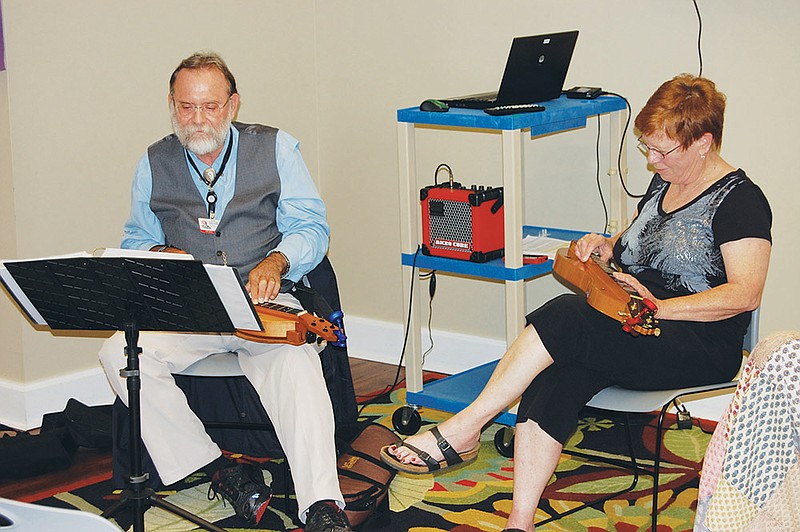BRYANT — For as long as there has been music, and medicine, people have noticed that when patients listen to music — or better yet, play it — they are calmer, complain less about pain and are more receptive to doing the things they need to do to get better.
Today, medical science has established in clinical tests that music helps with healing in some obvious and sometimes almost miraculous ways.
“I regard music therapy as a tool of great power in many neurological disorders, such as Parkinson’s and Alzheimer’s — because of its unique capacity to organize or reorganize cerebral function when it has been damaged,” said Dr. Oliver Sack, author and professor of neurology at the New York University School of Medicine.
Musicians who also know something about music’s therapeutic possibilities talked and played for a gathering at the Mabel Boswell Memorial Library in Bryant on Aug. 29.
Linda Brockinton is a nationally known mountain-dulcimer player and recording artist who teaches dulcimer and flute in Saline County.
Dr. Terry Harville of Arkansas Children’s Hospital and the University of Arkansas for Medical Sciences College of Medicine in Little Rock is also a dulcimer player and is interested in the relationship between the mind and disease.
The program started with an exhibition of music’s power to link with the human body. Brockinton asked those at the library’s meeting room to take their pulse with Harville timing them. Then Brockinton played her dulcimer for them.
“I started playing at 60 beats per minute, playing to match the heartbeat of people sitting down and listening,” she said. “Then I took the rate of the music down as I played, and it should make the heart rates go down.”
After the music, audience members checked their heart rates again, and many said their hearts had slowed while they listened.
“The human mind is always looking for harmonious and rhythmic sounds to help it function in the world,” Harville said. “Soothing music feeds the mind and soothes the soul.”
Brockinton, reading from information on the benefits of music, said it provides structure, and that helps those looking for structure in a hyperactive world.
“Today it seems everybody has ADHD (attention defective hyperactivity disorder),” she said. “I wonder how much comes from overstimulation. Play something soothing in the morning as your children get ready for school, and let the kids chill.”
While the connections of music to the human spirit have been recognized for centuries, serious medical attention of the effects of music were first published in the early 1800s.
Oliver Wendell Holmes Sr. a physician and American author, was a proponent of two types of hygiene.
“Take a music bath once or twice a week, … and you will find it is to the soul what the water bath is to the body,” he said.
Formal study of music therapy began in the 20th century after musicians went to play for veterans of both world wars in veterans hospitals across the United States. Studies have found that the brain’s reward center responds to music, releasing dopamine, Brockinton told the group in Bryant. The chemical is associated with pleasure.
“It takes all seven ways people have of learning to play and sing music, according to a study at Boston University,” Brockinton said.
Harville said that while listening is centered in the left side of the brain, tests have found that more areas of the brain “light up” when people listen to music.
“And the areas where they light up can be different in two different people,” the doctor said. “Music is using more of the brain and helps it in development and reducing distractions.”
Brockinton pointed out that stroke patients have said they find it easier to re-learn walking when rhythmic music or just drumbeats are used as they try to walk.
“When music is playing, you can see them work more normally,” she said. “They learn to work faster, and with something like Parkinson’s, the tremors stop while rhythmic music is playing.
“We have no clue how much power it has to heal.”
During the program, the musicans played a video of how one longtime nusing home patient was affected by playing some of his favorite music.
“The man had gone into himself,” the narrator explained. “He hardly spoke, did not recognize loved ones, and his head stayed down, and his arms were crossed and locked. After listening to band music from the 1940s and 1950s, he was humming along and looking up, moving to the music.
“Once the music was taken away, the results continued to enliven the patient. He talked about his love of the music, remembering his favorite bands, and even sang, remembering the words and notes.
“The music had helped him rediscover himself,” the narrator said.
“Patients with neurological disorders who cannot talk or move are often able to sing and sometimes even dance to music,” Dr. Sacks said in one of the videos. “Its advocates say music therapy also can help ease the trauma of greiving, lessen depression and provide an outlet for people who are otherwise withdrawn.”
While both Brockinton and Harville play for patients and have observed music’s results on patients, neither is a trained music therapist.
Today, some 5,000 musicians have earned degrees in music therapy and earned certification to treat patients. An annual report from Arizona State University’s School of Music, one of the nation’s largest music-therapy programs, states that 100 percent of the students who graduate from the program have jobs across the nation when they are finished with their studies.
“If I were not 60, I would go back to college and take music therapy,” Brockinton said.
The musicians played for the audience after the lecture and discussion. For more information about Brockinton, visit her website at www.lindabrockinton.com.
